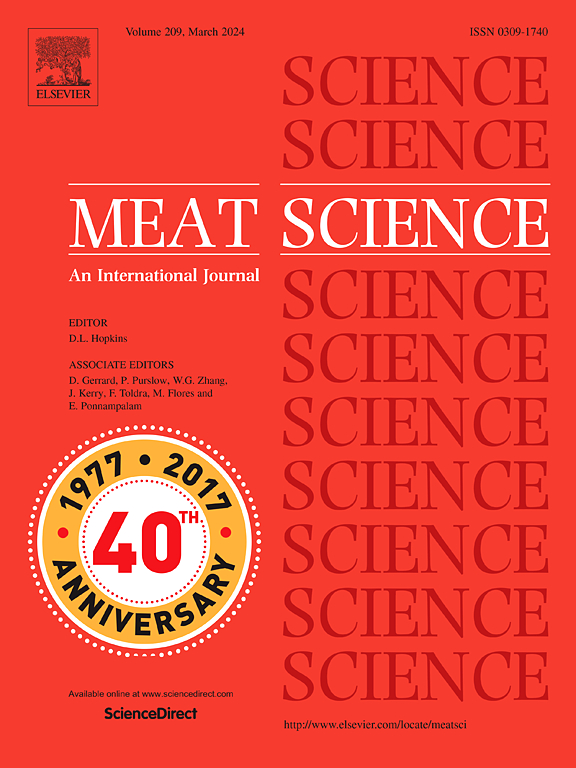Relationship between skin lesion severity and physiometabolic blood profile, microbial counts and carcass and meat quality characteristics in slaughtered pigs
IF 6.1
1区 农林科学
Q1 Agricultural and Biological Sciences
引用次数: 0
Abstract
This study evaluated the relationship between skin lesion severity and physiometabolic blood profile, microbial counts and carcass and meat quality characteristics in a total of 384 slaughter pigs from a single commercial farm. Skin lesion severity was visually assessed using a three-point scale. According to skin lesion severity, individual pigs were categorised into three groups: low skin lesion scores, moderate skin lesion scores and high skin lesion scores.
Low skin lesion scores in pigs, compared with other lesion score groups, were associated with the lowest whole blood lactate and glucose levels, as well as the lowest plasma creatine kinase (CK), lactate dehydrogenase (LDH), aspartate amino transferase (AST), alanine amino transferase (ALT), ceruloplasmin and malondialdehyde levels, but also with the highest plasma albumin, paraoxonase-1 and glutathione concentrations and frequency of red, firm and non-exudative pork (P < 0.05). High skin lesion scores in pigs, compared with the other lesion score groups, were associated with the highest plasma cortisol, CK, LDH, AST and ceruloplasmin concentrations and the lowest plasma albumin levels (P < 0.05). Meat from pigs with high skin lesion scores, compared with the other lesion score groups, presented the highest initial and ultimate pH, total viable counts, a* value, subjective colour scores and the greatest percentage of dark, firm and dry pork, while showing the lowest drip loss and L* and b* values (P < 0.05). Moderate skin lesion scores in pigs, compared with the other lesion score groups, were associated with the highest blood lactate and glucose levels (P < 0.05). Meat from pigs with moderate skin lesion scores, compared with the other lesion score groups, showed the lowest initial and ultimate pH, a* value and subjective colour scores, but had the highest initial temperature, drip loss, thawing loss, L* and b* values and the greatest percentage of pale, soft and exudative pork (P < 0.05).
In conclusion, both high and moderate skin lesion scores in pigs were associated with intense pre-slaughter stress and unfavourable pork quality characteristics.
屠宰猪皮肤损伤严重程度与生理代谢血谱、微生物数量及胴体和肉品质的关系
本研究评估了来自单个商业猪场的384头屠宰猪的皮肤损伤严重程度与生理代谢血谱、微生物数量以及胴体和肉品质特征之间的关系。皮肤损伤严重程度采用三分制进行视觉评估。根据皮肤损伤严重程度,将个体猪分为皮肤损伤低评分、皮肤损伤中等评分和皮肤损伤高评分三组。与其他损伤评分组相比,低皮肤损伤评分组猪全血乳酸和葡萄糖水平最低,血浆肌酸激酶(CK)、乳酸脱氢酶(LDH)、天冬氨酸氨基转移酶(AST)、丙氨酸氨基转移酶(ALT)、铜蓝蛋白和丙二醛水平最低,血浆白蛋白、对氧磷酶-1和谷胱甘肽浓度最高,红、硬、无渗出猪肉出现频率也最高(P <;0.05)。与其他损伤评分组相比,高皮肤损伤评分组的血浆皮质醇、CK、LDH、AST和铜蓝蛋白浓度最高,血浆白蛋白水平最低(P <;0.05)。与其他病变评分组相比,高皮肤病变评分组的猪肉具有最高的初始和最终pH值、总活菌数、a*值、主观颜色评分以及最大的黑、硬和干猪肉百分比,同时具有最低的滴漏损失以及L*和b*值(P <;0.05)。与其他皮肤损伤评分组相比,中度皮肤损伤评分组的猪血乳酸和葡萄糖水平最高(P <;0.05)。与其他损伤评分组相比,中度皮肤损伤评分组猪肉的初始和最终pH值、a*值和主观颜色评分最低,但初始温度、滴漏损失、解冻损失、L*和b*值最高,苍白、柔软和渗出猪肉的比例最高(P <;0.05)。总之,猪的高和中等皮肤损伤评分都与强烈的屠宰前应激和不利的猪肉品质特征有关。
本文章由计算机程序翻译,如有差异,请以英文原文为准。
求助全文
约1分钟内获得全文
求助全文
来源期刊

Meat Science
工程技术-食品科技
CiteScore
12.60
自引率
9.90%
发文量
282
审稿时长
60 days
期刊介绍:
The aim of Meat Science is to serve as a suitable platform for the dissemination of interdisciplinary and international knowledge on all factors influencing the properties of meat. While the journal primarily focuses on the flesh of mammals, contributions related to poultry will be considered if they enhance the overall understanding of the relationship between muscle nature and meat quality post mortem. Additionally, papers on large birds (e.g., emus, ostriches) as well as wild-captured mammals and crocodiles will be welcomed.
 求助内容:
求助内容: 应助结果提醒方式:
应助结果提醒方式:


